Basic Training: Trends in Learning & Development Departments
Pharmaceutical Executive
Can pharma take its talent-and its earning potential-to the next level with employee education?
Outside of pharma, the titans in information systems, consulting, and other industries have earned their "street cred" by collecting and publishing data that shows how training employees can drive performance as well as the organization's overall business strategies. So why hasn't a pharmaceutical company achieved the learning-giant status of an IBM or a GE? Despite multimillion-dollar budgets and some of the best technology money can buy, the pharma industry has yet to propel its own superstar into the limelight. The problem could be that pharma companies still haven't concentrated on measuring—and publicizing—their success.
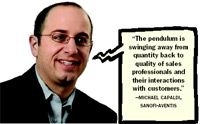
Michael Capaldi, Sanofi-Aventis
But that might be changing. Training departments are starting to take a high-profile role at many pharma, biotech, and medical device organizations.
The Society of Pharmaceutical and Biotech Trainers (SPBT) and Health Strategies Group worked together to create a 2007 benchmark study of 47 companies' learning-development practices. The participants represent more than 1,600 full-time employees in training, 83,000 salespeople, and more than $200 billion in 2006 US revenues (see "Methodology of the Study,"). The organizations' joint venture uncovered the training trends found throughout the industry.
Trend 1: More Development for More People
Sales training continues to be the bread and butter for many pharma and biotech learning and development (L&D) departments. Yet in recent years, upper management has halted the arms race in the field. Training departments are no longer churning out class after class of young sales recruits. Instead, heads of training are being asked to develop programs that make representatives better businesspeople, armed with negotiation skills and financial knowledge.
"The pendulum is swinging away from quantity back to quality of sales professionals and their interactions with customers," says Michael Capaldi, associate vice president, sales training and management development, Sanofi-Aventis. "Couple this with the need for field professionals to have more broad business acumen, and organizations are seeing training and development as a key driver for this change."

Trend in Linking Training to Competency Models
In concert with this trend, training departments have developed more formalized development programs for their senior sales management staff and regional and district managers. Marketing training, too, has become an area of focus. In 2005, only 14 percent of organizations offered training for brand managers. Today, 43 percent provide that training—with another 7 percent planning to add this offering in the next year. Genentech's commercial training and development organization—which comprises the marketing and sales groups—recently built a targeted curriculum for managers, marketers, account managers, and thought leader liaisons. One area of focus is compliance training. Genentech trainers worked with their company's healthcare-compliance office to develop comprehensive course content for training within the commercial organization. "Training is about being able to translate strategy into execution through skills development," says Carol Wells, senior director, commercial training and development, at Genentech. "Outside of the clinical and sales training that is typically provided by companies, Genentech also provides the support for several functional skills—including compliance, management development, selling and account excellence, marketing, and thought leader liaison training—which we believe will enhance the success of all our clinical specialists."
Some L&D departments are taking on nontraining responsibilities as well. At the medical device company B. Braun Medical, the training team leads the organization's national sales meeting, establishing the agenda based on input from the sales and marketing organization. "Our training department has gained a lot of credibility in recent years by heading up projects such as succession planning for field managers," says Kevin Glover, director of sales training and development. His department also leads the effort to create a defined sales process to help the company accelerate the growth of B. Braun's most profitable IV product. "Typically, these kinds of initiatives are driven by HR or marketing, but we [in training] are often asked to lead the effort. This gives us a high degree of influence."
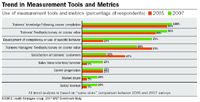
Trend in Measurement Tools and Metrics
Trend 2: Measurement Mania
Another factor that is helping pharma L&D departments command more corporate respect is better data. Training executives—not just inside the pharma industry—have known for some time that simple post-course evaluations that generate Level 1 ROI data aren't enough to justify future investments in training. These days, when training directors come together, the discussion often turns to metrics. "Organizational leaders are requiring that metrics be provided long after the event to show impact on performance and the bottom line," Sanofi's Capaldi says. "This doesn't necessarily mean cost savings, but rather that the training dollars spent actually lead to positive changes for the learner and their customers." Today's trainers also are armed with better tools to capture these metrics than in the past. For example, new technology on the market is allowing training departments to pool performance data, test results, financial data, and other metrics to create "dashboards." Using dashboards, trainers and managers can view an employee's performance on test scores, time to completion, and compliance on policy exams.
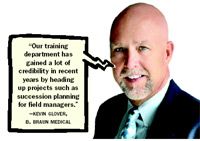
Kevin Glover, B. Braun Medical
Whichever measurement tools pharma companies choose to use, more are looking outside of the industry for answers. Firms like IBM, for example, have developed specific methodologies to assess how well their learning programs support their organizational objectives. IBM's five-step measurement methodology takes a proactive, rather than retrospective, approach to measuring how well training works. Instead of asking "What happened?" the model asks "What should happen?" and then "maps" the way for learning design and delivery.
Another key question that pharma trainers are asking is: What do we measure? When Pfizer shed its divisional structure for a more nimble business unit structure this year, Vice President of US Sales Training Tim Kern saw it as an opportunity to "open up training's wares" to other Pfizer groups, such as medical and marketing. When it comes to measurement, Pfizer tends to concentrate its efforts on new initiatives. "We focus on what are the real cost drivers, or what equates to real field-force effectiveness," Kern says. "The key is agreeing to what the evaluative metrics are up front." According to respondents in the 2007 benchmark study, the most commonly used metrics involve testing trainees' knowledge after a course; surveying learners on the course value; and developing competencies or standards of desired behaviors. Pharma organizations, like companies in other industries, continue to develop competency models for key roles like district managers and representatives. More than 90 percent of companies link their representatives' training to a competency model, while 85 percent of companies connect their DM training to a formalized standard.
In addition, more companies—27 percent of those surveyed, up from 7 percent two years ago—are looking to demonstrate that training can have an impact on sales force retention. Again we consider B. Braun Medical. Exit interviews in 2003 revealed that two of the top-three complaints among salespeople were learning related: Reps said they didn't get enough training and didn't have defined career paths. The organization's board of directors decided to resolve these issues by investing heavily in training. While other departments were asked to maintain or reduce existing expense levels year over year, the training department received increased headcount and discretionary budget in 2004, 2005, and 2006. At the end of 2006, turnover was 7 percent, down from 16 percent in 2003.
Trend 3: Trainers Cope with "Senior-itis"
When a new rep comes on board, companies dedicate an average of 62 days to training during the first year. After the first 12 months, training significantly drops off—to about two days a year. However, some companies are taking a new look at their training for tenured salespeople.

Trend in Learners per Trainer
One example is Allergan, with a sales force that has increased in recent years due to product launches and new indications. "Senior reps influence so many people and shape the culture of a company," says Jim Trunick, senior director, corporate training and development. "The question is, How much advanced training should we do?" Trunick and his team, like those at other organizations, are still trying to answer that question. Currently, Allergan is revamping its leadership-skills-development programs so that tenured representatives can better lead in district team scenarios. Allergan also offers a one-week, in-house training program for senior salespeople that includes role-playing and other exercises designed to improve skills around negotiations, presentations, and coaching.
It seems counterintuitive, training directors say—but the more that representatives learn on the job, the more likely it is that they might stay. That's been shown in other industries. For example, technology and learning giant IBM has conducted studies linking learning and employee retention. Employees involved in learning programs are 79 percent less likely to leave the company after three years.
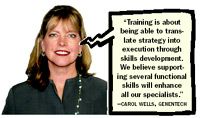
Carol Wells, Genentech
Other companies are looking at expanding their training for tenured sales staff—beyond the classic, corporate-university format. One midsize company is considering introducing pharmaceutical-education credits—similar to a doctor's required CME credits—that all tenured reps would need to earn each year. Completion of credits would be tied to bonuses or end-of-year increases.
While training directors express a desire to do more training of tenured salespeople, they recognize reality. These advanced programs are often the first to go when upper management asks for a budget cut.
Trend 4: Experimenting with Technology
Technology is also helping trainers follow through on classroom training. For example, a training department may distribute a Web-based training program to field sales teams 30, 60, or 90 days after a representative completes a course. But L&D departments are also moving to new offline options: Companies like Genentech and B. Braun are piloting programs using or have equipped their sales forces with iPods, allowing trainers to efficiently distribute video or audio podcast courses with relative ease.
Another technology that many training organizations rely upon is a learning management system, or LMS. These systems can help track course completion, enroll learners in classes, and, in some cases, analyze training effectiveness. Three-quarters of the companies surveyed use an LMS or plan to implement one in the next year.
One company adding an LMS in 2008 is emerging midsize firm Daiichi Sankyo. The company's head of training, John Sjovall, hopes the LMS—combined with a new enterprise-resource-planning system—will allow his department to better measure the impact of their training. "Our goal is to start doing clinical-type trials of our training programs," Sjovall says. "We'll run one group through a training segment, separate another group as the control, and then we'll compare the results."
In the meantime, he has found other ways to gauge the value of his company's training programs. For example, all Daiichi Sankyo trainers are required to spend time in the field with representatives and managers at least twice a quarter. Trainers also get valuable feedback when working with DMs on plan-of-action meetings, which Sjovall's department now manages. "In the past, POAs have been business meetings primarily. But since we have taken ownership, we are making them learning events to help fill in the gaps between classroom training. Basically, we are now building a business and training meeting in a box for our DMs to roll out to the reps," he says.
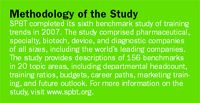
Methodology of the Study
Trend 5: L&D Departments Seek Productive Partnerships
As training departments in pharma, biotech, and device organizations continue to achieve higher profiles, one of the challenges will be finding the right consultants to provide the missing knowledge, skills, and technology. Currently, outsourcing accounts for about 27 percent of the departments' total budget.
Another challenge for trainers will be adapting to their growing consultative role, which may involve less action and more analysis. "It's becoming clear that if the industry doesn't address customers' concerns about the value of our sales forces, we put our traditional marketing approaches at risk," says Brian Fagan, executive director of SPBT. "Training can be part of the solution as the marketplace is becoming more complex. Some of the strategies that training departments are implementing to help the industry adapt include continuous quality-improvement processes, increasing trainer headcount, and providing physician and patient value beyond product. These L&D initiatives have worked in other industries, and we expect that they will help our sales organizations maintain their relevance to our customers." And as this unfolds over the next few years, it's possible that a pharma, biotech, or device company could stake out a reputation as an innovator—not only in battling disease, but in advancing learning.
Rayna Herman is a principal at Health Strategies Group. She can be reached at rherman@healthstrategies.com. Laura Ramos is editor of SPBT Focus magazine. She can be reached at lramos@spbt.org.
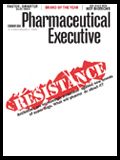
The Misinformation Maze: Navigating Public Health in the Digital Age
March 11th 2025Jennifer Butler, chief commercial officer of Pleio, discusses misinformation's threat to public health, where patients are turning for trustworthy health information, the industry's pivot to peer-to-patient strategies to educate patients, and more.
Navigating Distrust: Pharma in the Age of Social Media
February 18th 2025Ian Baer, Founder and CEO of Sooth, discusses how the growing distrust in social media will impact industry marketing strategies and the relationships between pharmaceutical companies and the patients they aim to serve. He also explains dark social, how to combat misinformation, closing the trust gap, and more.